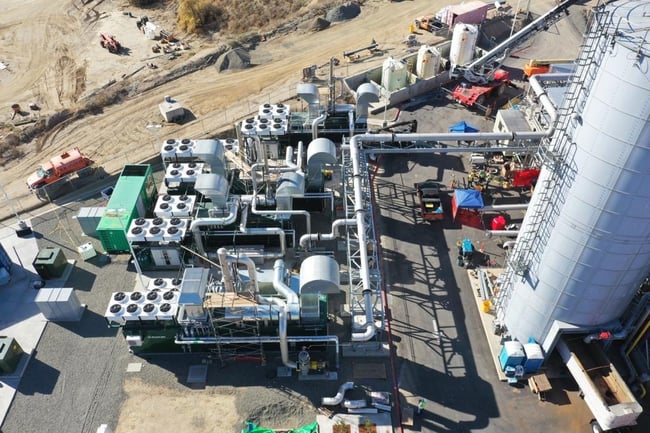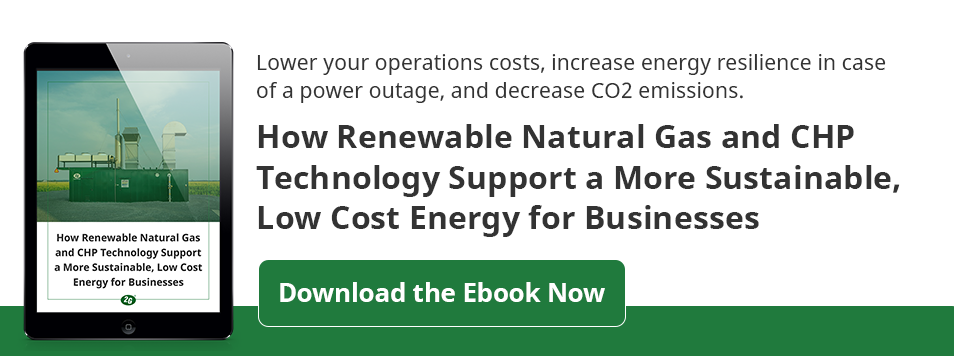How Creating a Renewable Natural Gas Site Improves Energy Efficiency
The entire planet runs on energy. We need it to heat our homes, cook our meals, and run hospitals, airports, and manufacturing plants.
However, these comforts and efficient processes come at a steep price — in addition to high energy costs, traditional energy generation has a harmful impact on the environment, the land, and our health. This is where alternative sources of energy like renewable natural gas can make things better for everyone.
What Is Renewable Natural Gas?
When organic matter (such as food waste, untreated wood, and animal manure) begins to decompose, naturally occurring bacteria release methane into the air. These gases are then purified through a scrubbing process that removes contaminants. Once cleaned, it becomes renewable natural gas (RNG). The amount of waste required to create RNG is substantial, so it is typically sourced from landfills, wastewater treatment plants, and dairy farms.
RNG differs from traditional natural gas in that the latter comes from deep underground wells, after it is sourced from crude oil (petroleum) and other fossil fuels such as oil shales and bitumens. Due to the way it’s created, RNG prevents land degradation that traditionally comes with drilling and fracking. It also reduces pollution, since it’s used with captured methane that would otherwise be released into the environment and contribute to global warming.
Sources of Biogas
Sources of biogas include any type of material that would be considered as organic waste. Common examples include:
- Food waste
- Landscaping and farming waste
- Untreated wood
- Animal manure
- Wastewater from treatment plants
- Landfills
How Is Renewable Natural Gas Produced?
Renewable natural gas involves gathering substantial amounts of organic matter (often from farms and/or landfills) and transporting them to a treatment facility. Once there, the matter is entered into sealed industrial containers that are known as anaerobic digesters.
These tanks have no oxygen and are designed to heat and mix the matter for several weeks before the natural gas can be produced. Once it’s ready to be turned into renewable natural gas, it goes through the following process:
- Bacteria in the waste matter releases methane, CO2, and sulfur. This process is known as fermentation.
- These fumes (known as biogas) are gathered and sent to a compressor.
- The compressor removes all contaminants from the gas. This process is known as purification. Once it's cleaned, it becomes renewable natural gas.
- The solid waste that’s left behind is known as digestate and it can be used as natural fertilizer.
How RNG Works With Combined Heat and Power (CHP) Systems
While the purification process turns biogas into RNG, it’s not necessary for biogas to go through the purification process to go into a 2G Energy combined heat and power system. This is because they are designed to work with a wider range of chemical compounds — much wider than those found in fully scrubbed renewable natural gas.
Once in the CHP technology, gas can then be used to create electricity, while at the same time capturing the heat generated by it to use as thermal energy — both to heat and to cool spaces.
These products range in size and electrical output, and can be interconnected for projects that have significant energy requirements. They also generate greener energy and cost-efficient power for large-scale operations, including:
- Food industry
- Greenhouses
- Grocery stores
- Landfills
- Hotels
- Universities
- Wastewater treatment plants
- Microgrids
- Data centers
- Waste management
- Residential development projects
In addition, 2G is the first in the industry to commercially have a 100% hydrogen CHP system, providing even more flexibility for your project as hydrogen becomes even more readily available in the marketplace.
Environmental Benefits of Renewable Natural Gas
Traditionally, electricity is produced by the combustion of fossil fuels. These fuels are the remnants of animals and plants that populated the planet millions of years ago. Since they reside deep within the Earth’s core, extensive mining and drilling has to be conducted in order to reach them. Doing this causes land degradation.
In addition, the fumes that are released into the air as these fuels are burned to create energy are toxic. There are plenty of studies linking them to health conditions such as asthma and certain types of cancer. To add insult to injury, they also contribute to global warming.
It is for all these reasons that industry leaders have been looking for ways to reduce the environmental and health impact. Renewable natural gas provides a viable solution in many ways:
It’s Sustainable
While there are vast amounts of crude oil, coal, and other fossil fuels underground, the reality is that the world’s needs far surpasses them. If fossil fuels continue to be sourced at the rate they have been extracted for the past several decades, reserves could be depleted by 2060. On the other hand, there will always be plenty of organic matter from which to create renewable natural gas.
It Reduces CO2 Emissions
Generating renewable natural gas emits approximately 60% less emissions than by burning fossil fuels. As a result, large-scale operations can decrease their carbon footprint and the role they play in global warming.
It Supports Environmentally Friendly Waste Disposal
Since renewable natural gas can be created from biodegradable materials already found in landfills and farms, there’s no need to create additional waste to generate energy. It also prevents such waste from spending years decomposing in landfills and/or ending up in waterways and affecting wildlife and human health.
While there are many facilities currently deploying renewable natural gas sourced from landfills, the Rialto Bioenergy Facility (RBF) in the greater Los Angeles area is the largest food waste diversion facility in the country. To put in perspective the environmental benefits of using renewable natural gas, the RBF converts 700 tons of food waste and 300 tons of biosolids per day into RNG, reducing their CO2 emissions by close to 220,000 metric tons annually.
While California has always been widely known for its efforts to diminish their carbon footprint, they aren’t the only ones being proactive about switching to RNG. In fact, from Texas to Florida, southern states are leading growth in biomass electricity generation.
Capital Outlay for RNG
One of the main concerns for people considering producing renewable natural gas is the associated costs. The reality is that deploying RNG technology does require significant upfront investments that often need to be financed.
In addition, once renewable natural gas is produced, it has to be processed in ways that meet regulatory standards, which poses additional costs. Finally, there’s the cost of interconnecting projects to a natural gas distribution network, which can be cost prohibitive in rural areas.
For all these reasons, federal and state authorities have begun to implement incentives to promote the use of RNG.
Incentives in the U.S. for RNG/CHP Deployment
There are many jurisdictions in the United States that are providing incentives for commercial enterprises and other institutions that use renewable energy.
1. Maryland CHP Incentive
Since 2016, the Maryland Energy Administration (MEA) has been offering a CHP grant program, for commercial, industrial, institutional, and critical infrastructure, as well as for the agricultural industry. Payments would cover up to 50% of installation costs (with a cap of $100,000). The program became so popular, it closed early in February 2021 due to overwhelming demand. However, in July 2021, the Maryland Energy Administration announced a second round of the program, which is stackable with other MEA incentives, up to $2.5 million.
2. California’s LCFS Program
California’s Low Carbon Fuel Standards (LCFS) program establishes a credit allowance for businesses in the state. Each credit represents one metric ton of CO2. Regulated entities that generate less than the allowable amount can sell their remaining credits to entities that need to emit more fumes to continue their operations. So far, the program has reduced CO2 emissions by 20%.
3. Biomethane Monetary Incentive Program
The California Public Utilities Commission (CPUC) adopted an incentive program providing 50% of the qualifying costs of switching to renewable natural gas, up to $3 million, or up to $5 million for dairy clusters, with a cap in funding of $40 million for the entire state, or until December 31, 2026, whichever happens first.
4. Energy Efficiency Financing for Public Sector Projects
Certain large-scale public-sector projects, such as public schools, colleges, public hospitals, cities, and counties qualify for low-interest loans from the California Energy Commission to switch to energy efficient power. Depending on the type of borrower, the loans can be interest-free.
5. Renewable Fuel Standard (RFS)
The Renewable Fuel Standard requires a specific volume of renewable fuel to replace petroleum-based fuels. These volumes are updated every year for different types of fossil fuel categories to be replaced with: biomass-based diesel, cellulosic biofuel, advanced biofuel, and total renewable fuel. Every use of these eligible fuels generates Renewable Identification Numbers (RINs), which can then be sold to other companies who need additional RINs to comply with the RFS.
6. Renewable Energy Production Tax Credit
Section 45 of the U.S. Tax Code provides for a tax credit for electricity generated by qualifying renewable energy resources. This credit is of 1.3 cents per kilowatt-hour (kWh) if power is generated from landfill gas, municipal solid waste, or biomass. This is known as the renewable electricity production tax credit (PTC).
7. Delmarva Power Combined Heat and Power Program
Delmarva Power, in Salisbury, Maryland, has been approved by the Maryland Public Service Commission to implement a CHP program, which offers payment of $250 per kilowatt (kW) to offset installation and engineering costs. It also offers an additional seven cents per kilowatt-hour (kWh) for an 18- month period after the CHP system startup.
8. Tax Credit for Carbon Sequestration (Section 45Q)
Section 45Q of the Internal Revenue Code (IRC) offers a tax credit for carbon oxides sequestration. The credit is computed per metric ton of qualified carbon oxide that’s captured and sequestered. The amount of the credit depends on the qualifying capture equipment.
Similarly, 30 states and Washington, D.C. have set renewable energy goals and require that a specific percentage of electricity must come from renewable sources. These are called Renewable Portfolio Standards (RPS) or Renewable Electricity Standards (RES), and while they vary from jurisdiction to jurisdiction, they offer credit trading systems that assist operations in reducing costs of complying with the requirements.
Commercial energy users, it's possible to get your CHP with no cash input from you.
2G Energy’s CHP Systems Support Your RNG Needs
2G Energy offers a wide array of CHP solutions for renewable natural gas. We also have an extensive portfolio of successful CHP projects in the U.S., Canada, and Europe, and have installed over 6,500 systems worldwide, including those used in the Rialto Bioenergy Facility.
Contact us to learn more about how CHP technology can transform your operations and significantly reduce your long-term energy costs.




